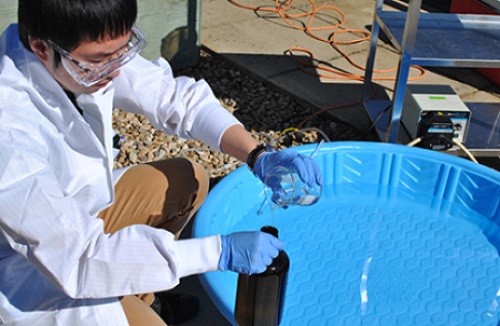Cleaning up oil sands tailings has just gotten a lot greener thanks to a novel technique developed by University of Alberta civil engineering professors that uses solar energy to accelerate tailings pond reclamation efforts by industry.
Instead of using UV lamps as a light source to treat oil sands process affected water (OSPW) retained in tailings ponds, professors Mohamed Gamal El-Din and James Bolton have found that using the sunlight as a renewable energy source treats the OSPW just as efficiently but at a much lower cost.
“We know it works, so now the challenge is to transfer it into the field,” says Gamal El-Din, who also worked on the project with graduate students Zengquan Shu, Chao Li, post doctorate fellow Arvinder Singh and biological sciences professor Miodrag Belosevic.
“This alternative process not only addresses the need for managing these tailings ponds water, but it may further be applied to treat municipal wastewater as well. Being a solar-driven process, the cost would be minimal compared to what’s being used in the field now.”
Oilsands tailings ponds contain a mixture of suspended solids, salts, and other dissolvable compounds like benzene, acids, and hydrocarbons. Typically, these tailings ponds take 20 plus years before they can be reclaimed. The solar UV/chlorine treatment process when applied to the tailings ponds water would make OSPW decontamination and detoxification immediate.
The sun’s energy will partially remove these organic contaminants due to the direct sunlight. But, when the sunlight reacts with the chlorine (or bleach) added to the OSPW, it produces hydroxyl radicals (powerful oxidative reagents) that remove the remaining toxic organics more efficiently. The chlorine leaves no residuals as the sunlight causes it to decompose.
In laboratory-scale tests the solar UV/chlorine treatment process was found to remove 75 to 84 per cent of these toxic organics.
“With this solar process, right now, the OSPW on the top of the tailings ponds is being treated. But because we have nothing in place at the moment to circulate the water, the process isn’t being applied to the rest of the pond,” says Gamal El-Din.
“Because we are limited by the sunlight’s penetration of the water, we now must come up with an innovative design for a mixing system like rafts floating on the ponds that would circulate the water. Installing this would still be much more cost effective for companies. It is expected that the UV/chlorine process will treat the OSPW to the point that the effluent can be fed to a municipal wastewater treatment plant, among other reclamation options, which will then complete the purification process sufficiently so the water can be discharged safely into rivers.
“This process has been gaining a lot of attention from the oil sands industry. We’re now seeking funds for a pilot-pant demonstration and are looking at commercializing the technology.”
Publication Reference:
Nian Sun et al: Advanced Analytical Mass Spectrometric Techniques and Bioassays to Characterize Untreated and Ozonated Oil Sands Process-Affected Water. Environmental Science & Technology, 2014.














Comments